Top 10 imperial tombs in China
Starting from Xia and Shang Dynasty in ancient China, the imperial tombs were concentrated in a certain area in accordance with blood relationship. These tombs covers extreamly vast areas, usually at least ten, or more than one hundred Li (half kilometer), however, according to the Chinese old saying, these imperial tombs are not easy to get close, go or not, you must think it over.
1. Qin Shi Huang Mausoleum 秦始皇陵
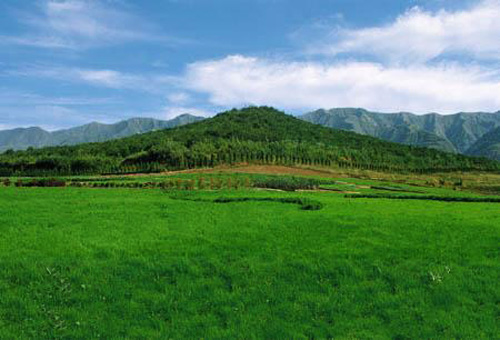 The mausoleum of Qin Shi Huang is the largest preserved one in China. It is a unique architectural ensemble whose layout echoes the urban plan of the capital, Xianyang, with the Imperial Palace enclosed by the walls of the city, themselves encircled by other walls.
The mausoleum of Qin Shi Huang is the largest preserved one in China. It is a unique architectural ensemble whose layout echoes the urban plan of the capital, Xianyang, with the Imperial Palace enclosed by the walls of the city, themselves encircled by other walls.
About 700,000 workers from every province of the empire toiled unceasingly until the death of the emperor in order to construct a subterranean city within a gigantic mound. The place was a veritable scale model of the palace, the empire and the world. Its treasures were safeguarded by automatically triggered weapons designed to thwart tomb robbers.
The main tomb containing the emperor has yet to be opened and there is evidence suggesting that it remains relatively intact.Sima Qian’s description of the tomb includes replicas of palaces and scenic towers, “rare utensils and wonderful objects”, 100 rivers made with mercury, representations of “the heavenly bodies”, and crossbows rigged to shoot anyone who tried to break in. The tomb was built on Li Mountain, which is only 30 kilometers away from Xi’an. Modern archaeologists have located the tomb, and have inserted probes deep into it. The probes revealed abnormally high quantities of mercury, some 100 times the naturally occurring rate, suggesting that some parts of the legend are credible.Secrets were maintained, as most of the workmen who built the tomb were killed.
2. Mausoleum of Genghis Khan 成吉思汗陵
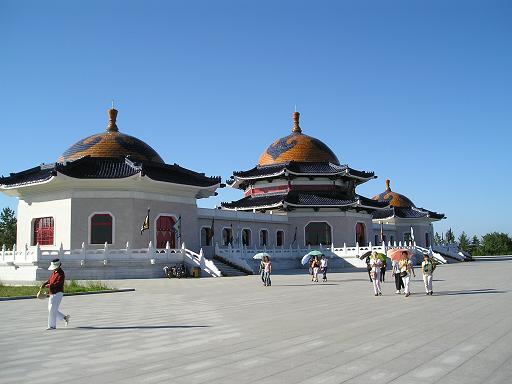 It is a national heritage site located in the Gandeli Grassland in Ordos City, Inner Mongolia. And because secret funeral is popular among Mongolian group, it is hard to find out the real tomb of Genghis Khan. The present mausoleum was built in 1954 and its construction style is simply magnificent. Genghis Khan, who had engaged in expedition all his life, had even extended the territory of Mongolia to the middle Asia.
It is a national heritage site located in the Gandeli Grassland in Ordos City, Inner Mongolia. And because secret funeral is popular among Mongolian group, it is hard to find out the real tomb of Genghis Khan. The present mausoleum was built in 1954 and its construction style is simply magnificent. Genghis Khan, who had engaged in expedition all his life, had even extended the territory of Mongolia to the middle Asia.
3. The Qianling Mausoleum 乾陵
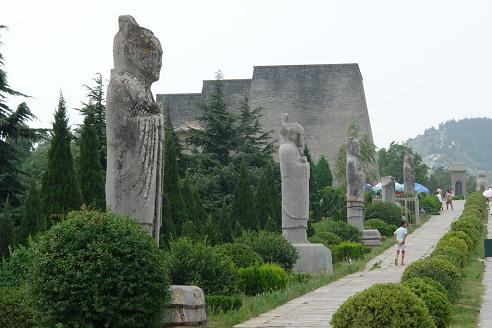 The Qian Tomb was the tomb where Gaozong Lizhi (628-663A.D.), the third emperor of the Tang Dynasty, and Wu Zetian (624-704A.D.), the only woman emperor in Chinese history, were buried together. It’s on the Mount Liang, 80 kilometers away from the Xian City. It was built in 684 A.D, and took 23 years.
The Qian Tomb was the tomb where Gaozong Lizhi (628-663A.D.), the third emperor of the Tang Dynasty, and Wu Zetian (624-704A.D.), the only woman emperor in Chinese history, were buried together. It’s on the Mount Liang, 80 kilometers away from the Xian City. It was built in 684 A.D, and took 23 years.
The scope of the tomb is very large with the precincts of the tomb and gardens totalling an area of 2,400,000 square meters. within this area stood 378 buildings that included the Sacrifice Hall, a Pavilion, a Hall of Ministers and numerous corridors. Unfortunately, the above ground structures have not survived unlike the stone sculptures that still delight visitors.
4. Ming Dynasty Tombs 明十三陵
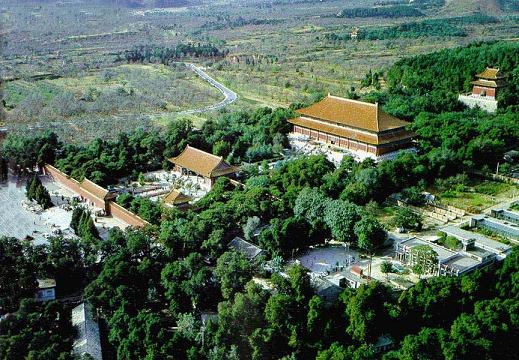 At a distance of 50 km northwest of Beijing stands an arc-shaped cluster of hills fronted by a small plain. Here is where 13 emperors of the Ming dynasty (1368-1644) were buried, and the area is known as the Ming Tombs.
At a distance of 50 km northwest of Beijing stands an arc-shaped cluster of hills fronted by a small plain. Here is where 13 emperors of the Ming dynasty (1368-1644) were buried, and the area is known as the Ming Tombs.
Construction of the tombs started in 1409 and ended with the fall of the Ming Dynasty in 1644. In over 200 years tombs were built over an area of 40 square kilometres, which is surrounded by walls totalling 40 kilometres. Each tomb is located at the foot of a separate hill and is linked with the other tombs by a road called the Sacred Way. The stone archway at the southern end of the Sacred Way, built in 1540, is 14 metres high and 19 metres wide, and is decorated with designs of clouds, waves and divine animals.
5. Huangdi Mausoleum 黄帝陵
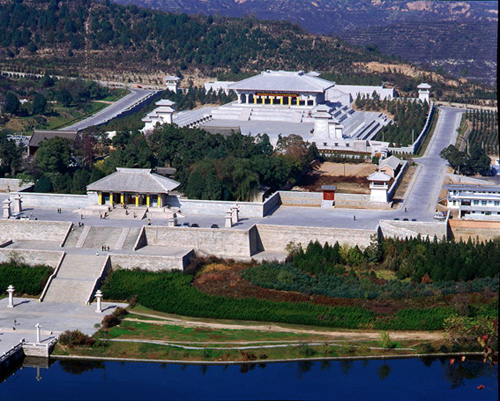 The Huangdi Mausoleum used to be called “Bridge Mausoleum” in ancient China due to its location on the Qiao Mountain or Bridge Mountain. According to historic data, Chinese had worshiped Yellow Emperor early in 442 BC and the mausoleum had become the site for national sacrifices since 770 AD (Tang Dynasty).
The Huangdi Mausoleum used to be called “Bridge Mausoleum” in ancient China due to its location on the Qiao Mountain or Bridge Mountain. According to historic data, Chinese had worshiped Yellow Emperor early in 442 BC and the mausoleum had become the site for national sacrifices since 770 AD (Tang Dynasty).
Huangdi, or literally Yellow Emperor in English, was a great Chinese chieftain born in 2697 BC and died in 2599 BC. He is said to have defeated the Yandi (or Yan Emperor), who was an outstanding leader of another big tribe living along the Wei River as well, and afterwards greatly boosted the national amalgamation and the forming of the Huaxia Nationality. That is the reason why Chinese always call themselves the “offspring of Huaxia”.
6. Ming Xiao Tomb Mausoleum 明孝陵
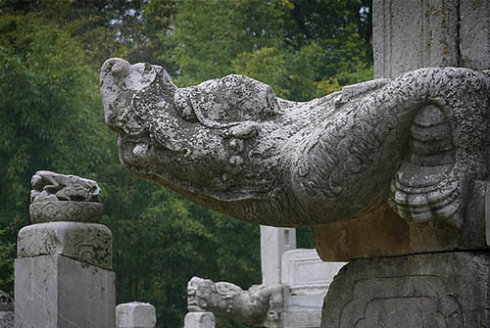 The Ming Xiao Tomb Mausoleum stands at the southern foot of the Zhongshan Mountain in Nanjing City. The tombs is for Zhu Yuanzhang, the first emperor of the Ming Dynasty and the Queen Ma are here.
The Ming Xiao Tomb Mausoleum stands at the southern foot of the Zhongshan Mountain in Nanjing City. The tombs is for Zhu Yuanzhang, the first emperor of the Ming Dynasty and the Queen Ma are here.
Construction of the mausoleum began in 1381, the following year Queen Ma died and buried here. The overall construction was completed in 1413, when the majestic stele was erected under the order of Emperor Zhu Di, the fourth son of Zhu Yuanzhang, eulogizing the merits and virtues of his father. The mausoleum is one of the first State Protected Cultural Relics and is enlisted as World’s Cultural Heritage by UNESCO.
7. East and West Qing Tombs 清东西陵
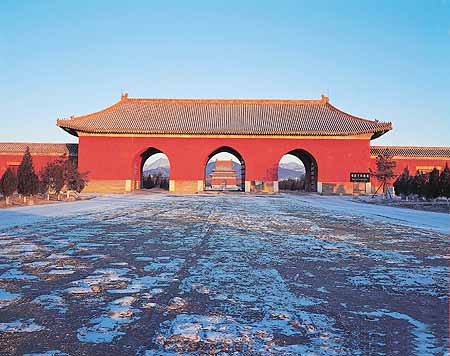 The Qing royal cemeteries are split be-tween two far-flung sites because of a fratricide’s guilt. Emperor Kangxi’s son Yongzheng usurped the throne from his brother, the designated heir, and executed him and his ministers. Worried about familial wrath in the afterlife, Yongzheng picked a burial site on the opposite side of the capital from his father. Subsequent emperors kept up the tradition of alternating between the two cemeteries.
The Qing royal cemeteries are split be-tween two far-flung sites because of a fratricide’s guilt. Emperor Kangxi’s son Yongzheng usurped the throne from his brother, the designated heir, and executed him and his ministers. Worried about familial wrath in the afterlife, Yongzheng picked a burial site on the opposite side of the capital from his father. Subsequent emperors kept up the tradition of alternating between the two cemeteries.
The most magnificent of the East tombs, Emperor Qianlong’s mausoleum was blasted open and plundered by the warlord Sun Dianying in 1928, with the unintentional upside that today’s tourists can enter the magnificent interior.
Thieves also couldn’t resist plundering Empress Dowager Cixi’s tomb, which cost 8 million taels of silver, but fortunately the real attractions are the spectacular carvings above ground. All the West Qing Tombs are open to visitors.
8. The Imperial Mausoleum of Xixia 西夏王陵
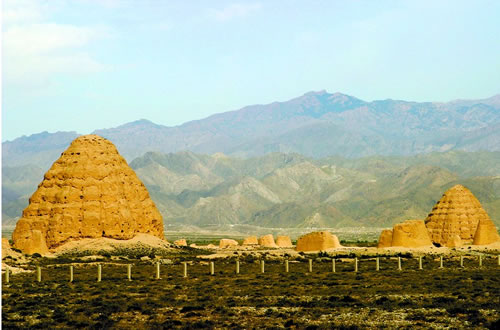 The Imperial Mausoleum of Xixia is located at the right foot of Helan Mountain, 30 kilometers west of Yinchuan City, the Ningxia Hui Autonomous Region.
The Imperial Mausoleum of Xixia is located at the right foot of Helan Mountain, 30 kilometers west of Yinchuan City, the Ningxia Hui Autonomous Region.
The Imperial Mausoleum of Xixia (1038-1227) is the mausoleum for the successive kings, 4 kilometers from east to west and 10 kilometers from north to south. Covering an area of about 40 square kilometers, the mausoleum has 8 imperial tombs and 70 satellite tombs. Each tomb yard of the mausoleum is a complete architectural group, with a floor area of over 100, 000 square meters. The ground buildings consist of turrets, gates, stele pavilions, outer city, inner city and divine walls.
9. Zhaoling Mausoleum 昭陵
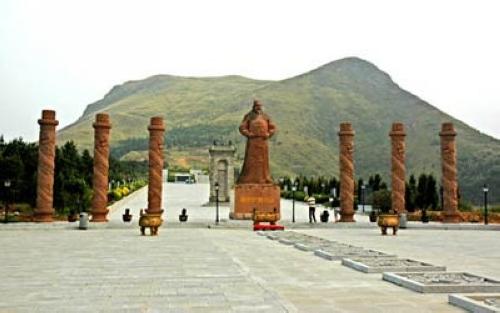 Northwest of Xi’an City seat in Liquan County is a thrusting peak named Jiuzong Mountain, on which lies the largest of the Tang imperial tombs — Zhaoling, the tomb of Li Shimin, Emperor Tai Zong. Li Shimin (599-649) was the second emperor of the Tang Dynasty, but its actual founder. His tomb is about 60 kilometers from Xi’an.
Northwest of Xi’an City seat in Liquan County is a thrusting peak named Jiuzong Mountain, on which lies the largest of the Tang imperial tombs — Zhaoling, the tomb of Li Shimin, Emperor Tai Zong. Li Shimin (599-649) was the second emperor of the Tang Dynasty, but its actual founder. His tomb is about 60 kilometers from Xi’an.
Construction of the tomb was a huge project, meticulous in design and flamboyant in structure. Historical data tell us Zhaoling’s underground palace was tunneled into the mountain. The tomb passage, about 230 metres long, was guarded by five stone gates. The tomb chamber, as luxurious as any, is flanked by eastern and western wings in which are arrayed stone boxes containing sacrificial objects.
10. Imperial Mausoleums of the Song Dynasty 巩县宋陵
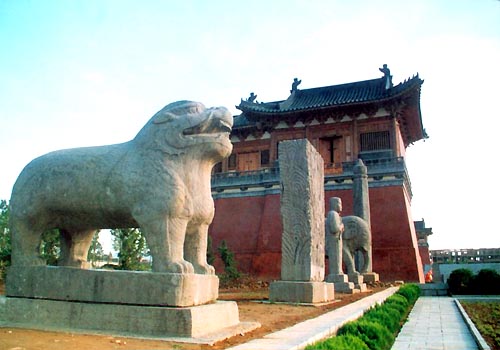 The imperial tombs of the Northern Song Dynasty (960-1127), the Song Mausoleums, are in western Gongxian County, Henan Province. Nine emperors of Northern Song were all buried here.
The imperial tombs of the Northern Song Dynasty (960-1127), the Song Mausoleums, are in western Gongxian County, Henan Province. Nine emperors of Northern Song were all buried here.
The seven mausoleums, plus that of Zhao Hongyin, father of founding Song Emperor Zhao Kuangyin, are popularly known as the Eight Mausoleums of Seven Emperors.
The Northern Song Dynasty founded its capital at Kaifeng but had its mausoleum area built in Gongxian County, 130 kilometers away. Designs of the eight mausoleums are generally alike, each mausoleum occupying an area of more than 120 mu (8 hectares) with a fairly large tomb terrace.


Then what about the tomb of Shangguan Wan’er?Or Princess Pingyang whose brother was an emperor and married Wei Zifu?